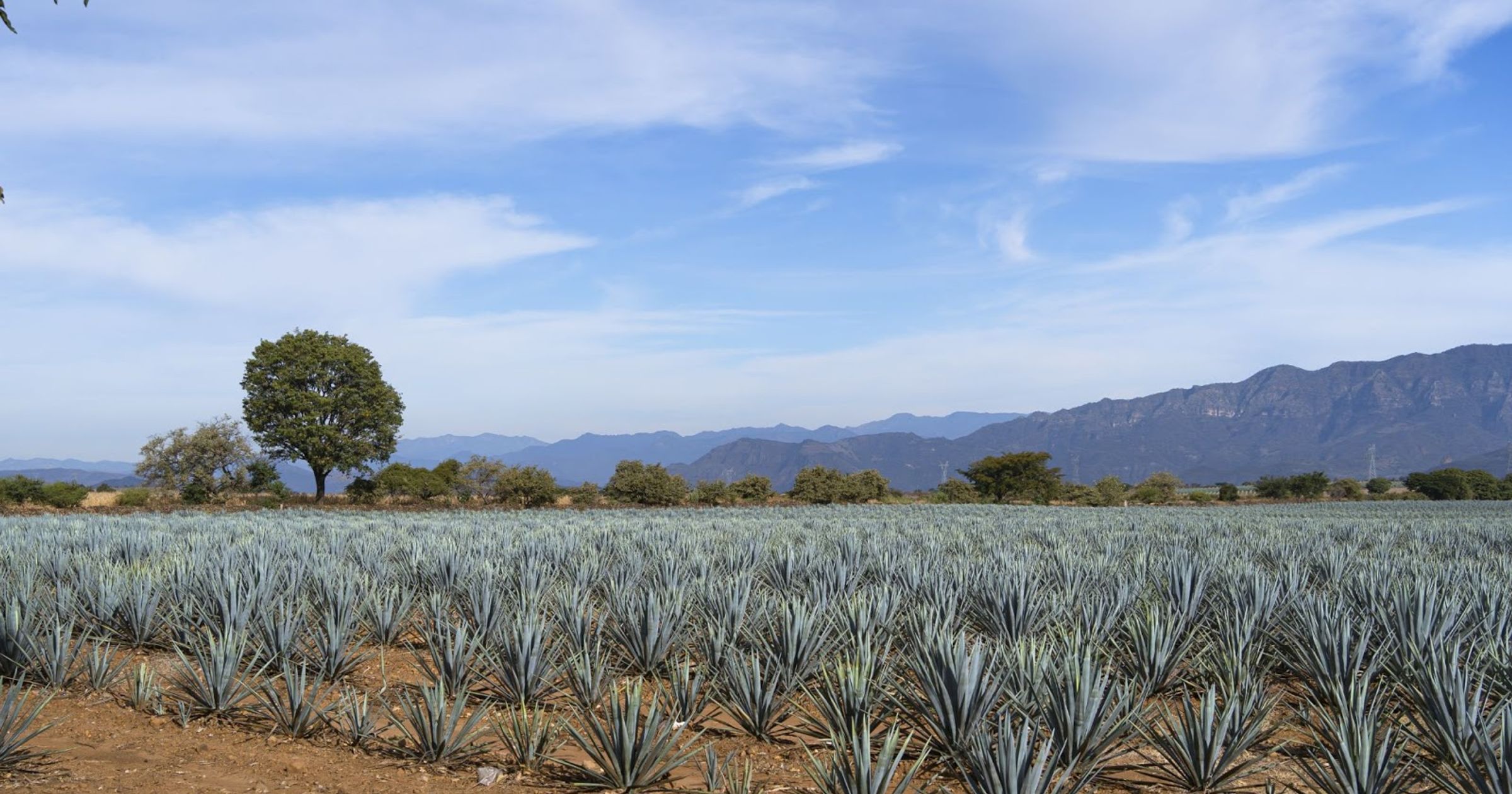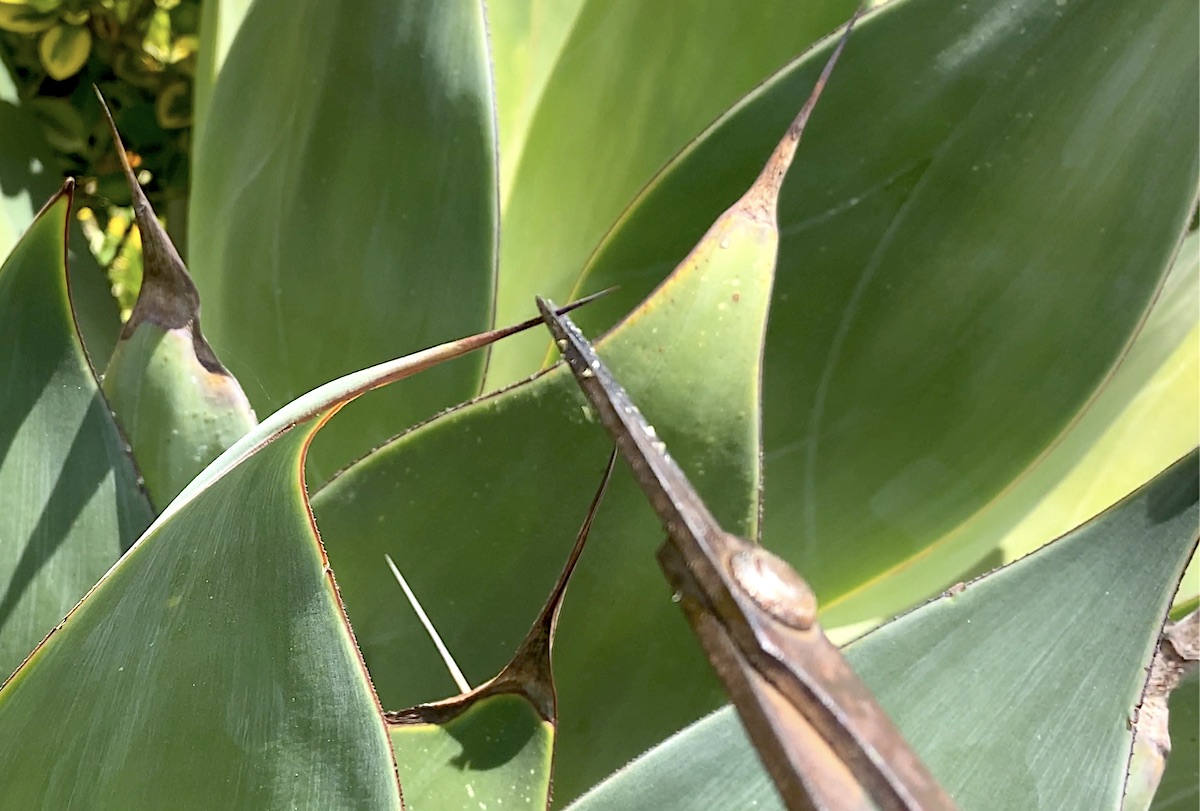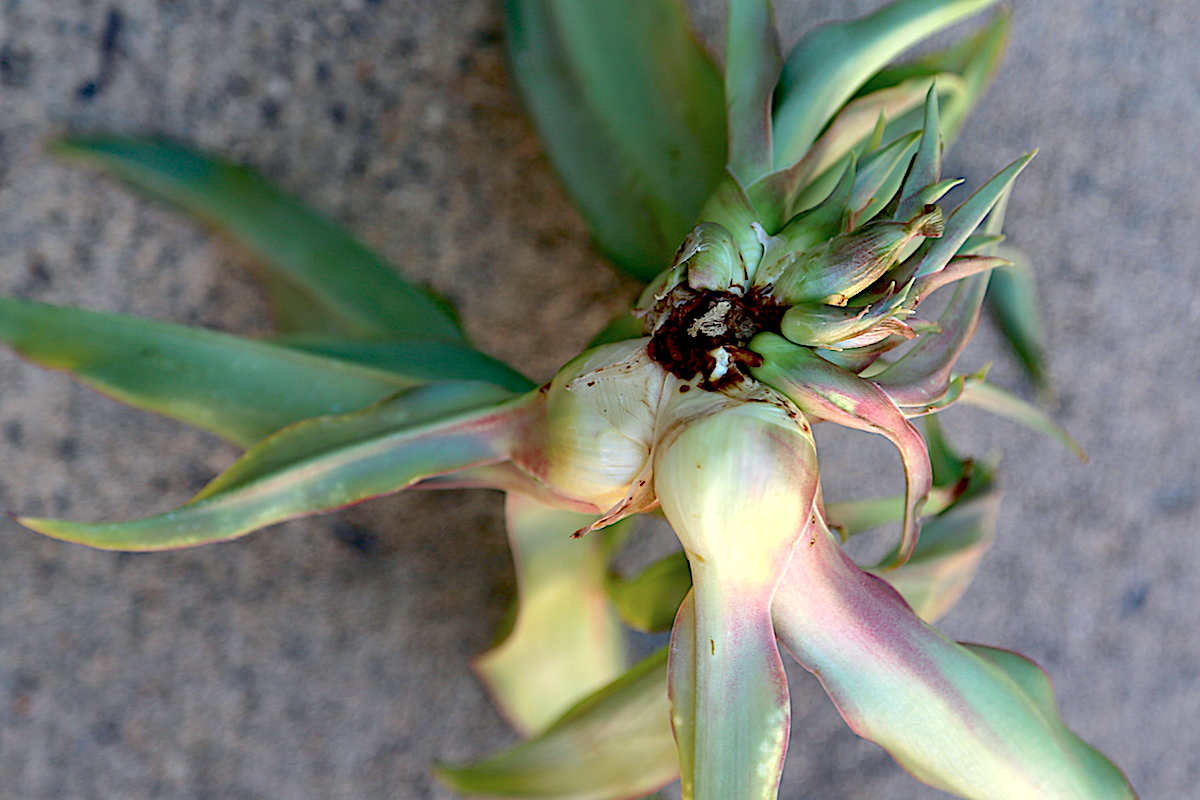What you need to know to successfully grow agaves. Gallery of 50+ garden agaves, all IDd
Most agaves are unfazed by harsh sun, high heat and minimal water. Their statuesque, fountainlike forms lend a sculptural element to any garden, and contrast beautifully with fine-textured plants. They also make good firebreak plants and security fences.
Bigger agaves are native to the New World, specifically the American Southwest, Mexico, and Central America. They can survive on rain alone and will grow in soils that don’t have many nutrients.
Although agaves like water, their roots—like those of most succulents—will rot in waterlogged soil. Plant them in coarse soil that drains well.
Except for a few soft-leaved and variegated types, all agaves need sun—the more the better—in all climates except deserts.
When you cut off a damaged leaf, remember that a straight-across cut in the middle will throw off the flow of the agave. It’s best to cut the leaf in half twice so that the ends are shaped like a “V.” Or cut the leaf all the way to the trunk. See how.
Agaves smaller than basketballs make excellent potted plants. Small agaves—there are many—look best displayed one to a pot. And any large species, when young, is fine in a container, in fact, will stay smaller longer.
Agave is an amazing plant that has been used by humans for thousands of years. From being a valuable food source to making drinks like tequila and mezcal, the agave plant has many uses. But with over 200 species of agave, it can get confusing figuring out exactly how many types there are. In this article, we’ll explore the different species and uses of agave so you can appreciate the diversity and wonder of this incredible plant!
A Little Background on Agave
Agave is a genus of over 200 species of flowering plants native to the hot and arid regions of Mexico, Central America, and the southern United States. Agaves are succulents with a large rosette of thick, fleshy leaves that end in a sharp point. The size and shape of the leaves can vary greatly between species.
After agaves mature which takes 5-30 years depending on the species they send up a tall flower spike up to 40 ft high. After flowering, the mother plant dies. Thankfully, agaves produce offsets or “pups” that can continue the growth process.
Agaves have been an important plant for indigenous peoples of Mexico and the Americas. The agave hearts and shoots were roasted and eaten as a vegetable. Fermented agave sap produced the alcoholic drinks pulque and mezcal. Agave fibers were used to make ropes, sandals, and textiles.
Today agave is still incredibly useful. It’s most known for being the source of mezcal and tequila but it has many other applications too. Extracts from agave are used as binding agents, emulsifiers, and sweeteners in processed foods. The fibers are used to make rope and special papers. Landscapers and gardeners love agave’s unique architectural qualities. And new research has revealed agave’s potential as a biofuel crop.
How Many Species Are There?
The exact number of agave species is still being researched, but experts recognize around 270 types Here are some of the major species
Agave americana – The century plant. A classic agave grows in a rosette shape up to 6 ft tall with gray-green leaves. Takes 10-30 years to bloom. Native to central Mexico.
Agave angustifolia – Caribbean agave. Grows in Cuba, Jamaica, and the Virgin Islands. Leaves are long, narrow and green. Grows up to 10 ft tall.
Agave tequilana – Blue agave, used to make tequila. Grows 5-8 ft with blue-gray leaves. Only agave that can be used for tequila. Native to Jalisco, Mexico.
Agave salmiana – Green giant. Grows huge, up to 15 ft tall and 15 ft wide. Has massive green leaves with curved spines along edges. Takes 20-30 years to bloom. From Central Mexico.
Agave parryi – Parry’s agave. A smaller artichoke agave with gray-green leaves. Grows in rosette shape up to 3 ft tall. Varieties found in Arizona, New Mexico, and Northern Mexico. Slow growing.
Agave palmeri – Palmer’s agave. A large species up to 6 ft tall with broad leaves that are deeply concave. Spines along leaf edges and terminal spine. Native to Mexico’s Chihuahua Desert.
Agave vilmoriniana – Octopus agave. Has wild, twisting tentacle-like leaves extending out from center. Leaves are dark green with curved spines. Grows 4-6 ft tall and wide. Very rare in the wild. Native to Mexico.
Agave attenuata – Foxtail agave. Distinctive agave with flexible leaves that lack spines. Leaves are pale green and curve down like a fox tail. Grows up to 3 ft tall and wide. Native to Central Mexico.
This covers some of the major species, but there are rare and lesser known agaves from remote regions continuing to be documented. Exciting new species are still being discovered!
The Most Common Agaves Used for Mezcal Production
While not all agave species can be used to make mezcal, there are around 30 types that work. The 5 most common varieties used are:
- Espadín – Makes up 90% of mezcal production. Considered the “workhorse” agave. Matures in 6-8 years. Produces a lighter, more floral mezcal.
- Tobalá – The “king” of agaves. Very rare in wild. Matures in 12-15 years. Makes an expensive but delicious sweet, fruity mezcal.
- Tepeztate – Grows in high altitudes and steep cliffs. Matures in 15-25 years. Creates an intensely flavored smoky mezcal.
- Tobaziche – Also called Cenizo. Savory, herbal tasting mezcal. Looks can vary based on region grown.
- Arroqueño – Large 10 ft wide leaves. Takes 25 years to mature. Floral, vegetal, and chocolate notes.
While espadín makes up the bulk of mezcal, the rarer agaves like tobalá and tepeztate make exceptionally unique and prized spirits and command premium prices.
Key Differences Between Agave Species
With so many agave types, there can be big differences in appearance, growing requirements, and uses between species. Here are some key distinguishing factors:
- Size – Agaves range dramatically in size. Small species like A. parryi grow under 3 feet, while large species like A. salmiana can top out over 15 feet tall and wide.
- Leaves – The shape, thickness, color, and edge spines of agave leaves vary. Spines can be long and wickedly sharp or almost nonexistent. Leaves range from rigid and upright to flexible and pendulous. Colors include green, gray-green, bluish, and variegated.
- Growing Conditions – While most agaves prefer hot, dry climates, some species are adapted to tropical or coastal regions. Others thrive at high altitudes over 9,000 ft.
- Time to Maturity – Depending on the species, agaves take 5-40 years to reach maturity and flower. Slow growers like Tobalá (12-15 years) and Tepeztate (15-25 years) take much longer than Espadín (6-8 years).
- Mezcal vs. non-Mezcal producing – Only around 30 species of agave contain enough fermentable sugars to make mezcal. The rest are ornamental or serve other purposes.
- Flavor – When made into mezcal, different agaves produce unique tasting notes from fruity and sweet (Tobalá) to savory and herbal (Tobaziche).
Why Such Diversity in Agaves Exists
Agaves display a wide diversity of physical forms and adaptations. But why? Here are some of the key evolutionary drivers that led to so many different agave types:
- Specialized pollination – Agaves rely on bats, birds, and other wildlife to pollinate their flowers and spread seeds. Different pollinators likely drove speciation.
- Adaptation to microclimates – With agaves found from tropical environments to high deserts, adaptations to unique moisture, sun, and soil conditions likely led to genetic divergence.
- Geographic isolation – Remoteness and geographic barriers like mountains and canyons separated some agave populations, allowing speciation to occur.
- Human cultivation – Humans have grown and hybridized agaves for thousands of years, accelerating the emergence of new varieties.
- Random mutation – DNA mutations created genetic diversity that was passed down and spread through offset propagation. Beneficial mutations were selected for.
The evolution of agaves is ongoing. As agaves adapt to changing climates and environments, we will continue to see new types emerge. Human-influenced hybridization also contributes to new varieties for cultivation.
Appreciating Agave Diversity
Hopefully this article gave you an appreciation for the incredible diversity found within the agave plant genus. Next time you see a majestic century plant or sample an artisanal mezcal, think about the millennia of evolution and human ingenuity that went into creating such an amazing plant. Agave is truly a wonder of nature!

Know how big any given agave will get
People who work with succulent nurseries and landscape designers have a big advantage: they know how big different types of Agave will get over time and can help people choose the right plants and put them in the right places.
Case in point: Blue agaves often appear interchangeable when young and in one-gallon nursery pots. But when they’re fully grown, Agave americana and Agave ovatifolia (both in the Gallery below) are very different. Plus, one sends forth pups that spread prolifically, and the other politely doesnt.
Sharp points at leaf tips and along leaf edges can make agaves treacherous. If this is a concern, snip about a quarter inch from needlelike tips with garden clippers.

Nothing easier. Agaves start readily, even those lacking roots. Just put the rosette on top of loose soil and keep it out of direct, hot sunlight while its roots grow. Roots will form from tissue at the base of the plant. Once rooted, an agave is able to hydrate its tissues and wants or can handle greater sun.

One of the most widely grown is A. americana (century plant), because it offsets so prolifically from lateral roots. Baby plants that pop up are “pups. ” Simply dig and replant.
When an agave blooms, you may get a bonanza of baby plants, or “bulbils. ” Those at the bottom of the flower stalk mature first. Cut off the stalk or wait for it to fall on its own, then twist off bulbous babies. In nature these may root on their own, but its best to give them a head start. Fill a pot with potting soil and put the bulbil on top of it. Place the pot in some shade and make sure the soil stays moist. If you gently pull on the leaves and the plant doesn’t move, it’s ready to go in the garden.
All but a few agaves are monocarpic, meaning they bloom once and then die. This may take as many as 25 years, but it will happen.
When its life cycle is over, a rosette that has been in a garden for years sends up a tall flower stalk. Most, but not all, branch. The plant puts all its energy into flowering and eventually dies.
Flowers along the stalk eventually turn into miniplants (bulbils) or seed capsules from which new agaves can grow.
Only the individual agave that flowers dies. In some cases—notably Agave americana species—a litter of pups will carry on.
Most Popular Agave Varieties: A Guide to Identification (With Pictures)
FAQ
How many varieties of agave are there?
How many types of agave are used for tequila?
What is the most common agave?
How many agave species are there in Mexico?
How many types of agave are there?
The 250 different varieties of agave are used for a great many different purposes, including as ornamental and decorative plants for gardens and planters. Below are 16 different types of agave plants to help you identify them or to help you choose the one that is best suited for your purpose. 1. American Century Agave
Which genus does Agave belong to?
The genus Agave is part of the family Agavaceae. It contains around 200 species, most of which are from Mexico, the southern United States, and South America. Plants in this genus are characterized by forming rosettes of fleshy (succulent) leaves which have a sharp point or spine terminally.
What is an agave plant?
The Agave (pronounced a-GAH-vay) plant is a genus native to hot and arid regions of the Americas and tropical areas of South America. Agave plant types thrive in intense heat and sun. They require very little supplemental water to survive. Most varieties are evergreen with very little ability to handle frost.
What is the best agave plant?
Squid agave is a popular choice for those who want an agave that will grow quickly. This variety can reach heights of up to six feet, making it the perfect choice for people who want a big statement plant. It does best in full sun and requires regular watering. 19. Thorncrest Century Plant (agave lophantha)
What do agave plants look like?
Agave plants have thick, sword-like leaves that are sharply pointed at the end. The leaves are typically green or blue, and may have a variegated pattern. The flowers of agave plants are very dramatic, and can be up to six feet in diameter. They grow on a tall stalk from the center of the plant, and are typically a bright yellow or orange.
How long do agave plants live?
Agave plants are monocarpic, meaning they bloom once and then die. Few Agave species take a full 100 years to do this. When an Agave blooms, it sends up a large flower stalk out of the center of the plant that grows very quickly.
- The Ultimate Guide to Growing Strawberries in Raised Beds - August 8, 2025
- No-Dig Garden Beds: The Easiest Way to Grow a Beautiful Garden - August 6, 2025
- How to Protect and Preserve Wood for Raised Garden Beds - August 6, 2025
